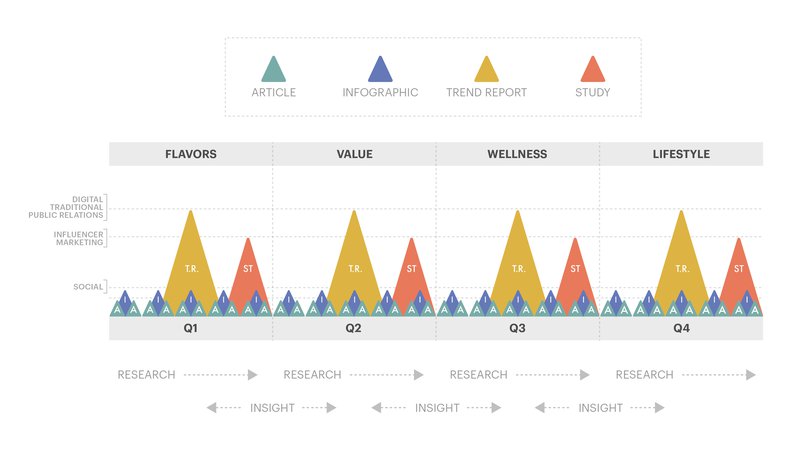Supercharge Your Results with a Hero Content Campaign
Five reasons insight-rich content lifts marketing and sales outcomes
When it comes to your content marketing, do you ever feel like you’re just plodding along without seeing the engagement boost you thought was in store? You follow all the best practices - create a plan, establish a calendar, publish new content on a consistent basis, evaluate metrics, etc. - but nothing seems to be moving the needle with a substantial jump.
Your situation isn’t uncommon. Especially when consumers encounter an endless amount of formidable content. Many brands need some extra muscle power - a (super) hero content program - to fuel stronger results.
Every strategy needs a hero
Think of a hero content campaign as the bright beacon that draws your target audience into your brand journey. Generally, it sits right at the top of your marketing funnel with open arms and connects them to your organization more deeply than a typical blog post or email.
Done right, a hero piece is so intriguing that it compels people to give up their closely guarded contact information. Often times, it’s an interactive quiz or video. It can be a landing page that aggregates user-generated content. Or, it can take form as an insight-rich whitepaper or industry report.
Whatever shape the piece takes, it’s important to keep in mind that hero content requires an investment of time and money. As such, most organizations create one per quarter or one to two times per year depending on their budgets.
The incredible powers of hero content
If your marketing engagement is in need of a rescue mission, here are a few more reasons to consider adding a hero content program(s) to your plan.
1. Strengthen your content strategy
A hero content program helps you become a consistent, meaningful part of a customer’s life versus just crashing in and out of it. While your hero piece is generally one meatier piece of content, it paves a path for you to share additional brand and product or service content with your desired audience. These activities, which occur over a defined period of time through marketing automation, should ideally lead to a purchase, plus ongoing customer engagement.
This was the case with one of my favorite hero programs, the Entrepreneurs’ Organization (EO) Personality Quiz. The interactive quiz, created with the dual goal of engaging busy entrepreneurs and collecting qualified leads for our client, features questions and member videos that reflect the complexities of the entrepreneurial journey. Following the quiz, participants received personalized results and a timed drip email campaign that reinforces EO’s benefits.
Beyond attracting roughly 7,000 participants and over 225 qualified leads, the quiz results gave our clients valuable insights about their audience’s personality traits which could be used to inform future hero programs.
2. Spark team creativity
Think of hero content as your Super Bowl commercial moment. It transcends the typical blog post or product sell sheet, giving people something that’s so engaging and so relevant to them. Some of my favorite examples are the Third Love What’s Your Fit quiz and Superdrug’s Perception of Perfection user-generated study.
To meet these high creative standards, your team or agency needs to get inside your audience’s mind and noodle on what makes them tick. Get the brainstorming process started with questions like:
- What keeps them up at night?
- What are they curious about?
- What types of information are they searching for in relation to our industry? (Note: This requires some keyword research and reviewing website analytics)
- What types of stories or content have performed well for us in the past?
- What are our competitors doing? Where can we fill in the gap?
- How can we share our information or story in a way that’s different than anything we’ve done before? Can we do a video or quiz? Or does this information make more sense as an in-depth report?
3. Encourage easy repurposing
Another great aspect of hero content is that it doesn’t work in isolation. Once you have your big hero piece, you can break it down into a number of sidekick pieces such as a blog series, infographics, e-newsletters social posts, etc. for a comprehensive three to six-month promotion.
As an example, one of our clients in the food and hospitality industry produces a quarterly consumer trends report centered around a relevant theme. While we give the full report lots of attention - promoting it through paid media and sharing it with influencers and journalists - we also create small studies, infographics and blog articles that connect back to the bigger piece. This process extends the shelf life of the hero program, allowing us to promote it over the span of an entire quarter.

4. Drive organic growth
When hero content strikes the right chord, people share it for you. News outlets or influencers will pick it up. Your customers and prospects will pass it along to their own communities. Ultimately, your audience has the potential to grow much more than it does with a typical blog or social media post.
For example, our recent #EatforCLE advocacy campaign, a pro bono initiative that’s anchored by an emotionally-charged video featuring restauranteurs discussing the impact of the COVID-19 crisis on their businesses, has exceeded every goal and expectation. Beyond encouraging people to watch the video, it calls for them to show their support for the food community with the hashtag #EatforCLE. We’ve reached thousands of video views, reshares and user-generated posts - all on a shoestring media budget.
5. Doesn’t always require massive investment
While big budget productions work well, it’s the ability to deliver a good, authentic story that’s most important. Like the #EatforCLE initiative mentioned above, we didn’t need to invest thousands or millions of dollars to get attention. The story and call to action were powerful enough. Since launching, we’ve had three journalists contact us to write stories on it. When you think about your own hero concept, be sure to ask yourself if it’s creative or newsworthy enough to be covered in the press.
Keep in mind - if it doesn’t require a big budget, it will require an investment of your team’s time and creative energy. Plan accordingly.
Timing is everything
If you’re ready to produce your next hero content piece, plan it around your most high-profile events or activities. For example, many retailers plan hero content around the Super Bowl or the holiday season. Many of our membership and education clients release theirs at Annual Meetings or conferences. If you’re planning to do more than one or two pieces, maybe plan the others during down time when competition for attention is less fierce.
Find the hero that lies within
Think beyond the typical product or service messaging to identify your own hero-worthy stories. Once you nail down the right idea, work with your team or agency to package it in such a way that makes sense for your audience and draws the special kind of engagement that leads to profitable action.
About the Author
Alex is the Content Manager at Muse. In this role, she develops editorial strategies brand stories and press pitches that fuel Muse clients’ marketing activities. Prior to Muse, she worked as a content marketer and strategist for nonprofits and large corporations, including University Hospitals, Flash Seats® and the Council of Smaller Enterprises (COSE). She earned her Master’s and undergraduate degrees from University of Dayton.
More Good Reads

Modern Wellness Customer Personas: 2025
How to target different wellness motivations of consumers, updated for 2025.

Your Marketing Playbook for Consistent Planning & Execution
Gain direction & cohesion for your marketing efforts using our free marketing playbook. Save your marketing department time & resources.

